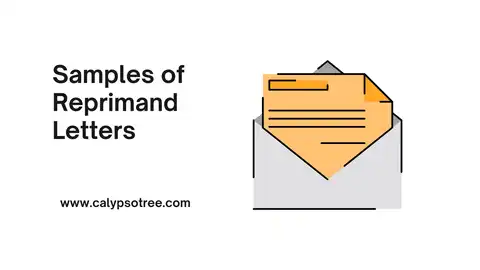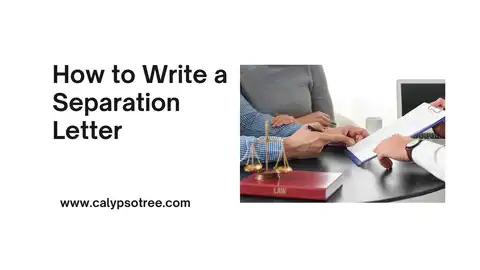A legal guardianship letter is a document that lets someone take care of a minor child. This letter is very important because it explains the guardian’s rights and duties. It is often used when parents cannot care for their child temporarily. This guide will help you understand a legal guardianship letter and how to write one.
Why You Need a Legal Guardianship Letter
This letter is useful if you need to be away for a while. It helps when a child needs to live with a guardian for a certain period. The letter explains who the guardian is and what they can do.
How to Create a Legal Guardianship Letter
Creating a legal guardianship letter is simple. Follow these steps to make sure your letter is clear and complete:
- Introduction: Start with a clear statement that you are giving guardianship. This should include your name and your relationship with the child.
- Details of the Guardian: Write the guardian’s name, address, and contact information. Include all the details so the guardian can be easily reached.
- Details of the Child: Include the child’s name and date of birth. This helps identify the child.
- Duration of Guardianship: State how long the guardianship will last. This can be for a specific period, like from one date to another, or until further notice.
- Responsibilities and Rights: Outline what the guardian can and cannot do. This may include making medical decisions, enrolling the child in school, and daily care tasks. Be specific to avoid misunderstandings.
- Signatures: Both the parent and the guardian should sign the letter. This makes the document official and shows that both parties agree.
- Notarization (Optional): Having the letter notarized adds a layer of legal protection. A notary public can witness the document’s signing, helping verify its authenticity.
Benefits of a Legal Guardianship Letter
Clarity and Peace of Mind: This letter explains who will care for your child and what they are allowed to do. It helps avoid confusion and makes sure everyone understands their roles.
Legal Protection: It can protect the guardian and the child. It shows that the guardian has been allowed to care for the child, which can be important in emergencies or legal situations.
School and Medical Decisions: It can enroll the child in school, make medical decisions, and take care of other important matters.
Temporary Care: If you must be away for a while, this letter lets you make sure your child is well cared for without transferring permanent custody.
Stress Reduction: Knowing that your child is in good hands can reduce stress. It can also help you focus on your tasks, whether they involve work, travel, or personal matters.
Parts of a Legal Guardianship Letter
- Introduction: Start with a clear statement that you are giving guardianship.
- Details of the Guardian: Include the guardian’s name, address, and contact information.
- Details of the Child: Include the child’s name and date of birth.
- Duration of Guardianship: State how long the guardianship will last.
- Responsibilities and Rights: List what the guardian can and cannot do.
- Signatures: Both the parent and the guardian should sign the letter.
Important Tips for Writing a Legal Guardianship Letter
Be Clear and Specific
When writing a legal guardianship letter, it’s important to be clear and specific. You must write down exactly what the guardian can and cannot do. This might include making medical decisions, enrolling the child in school, and caring for daily needs. Being clear helps everyone understand their roles and avoids any confusion.
Make Sure Both Parties sign the Letter.
Both the parent and the guardian should sign the letter. This makes the document official and shows that both agree to the terms. If both parents have legal custody, they both should sign the letter. Signatures are important because they make the letter valid and legally binding.
Keep a Copy of the Letter for Your Records
Always keep a copy of the guardianship letter for your records. This is important in case you need to refer to it later. You should show it to schools, doctors, or other authorities. Having a copy ensures you have proof of the agreement.
It May Be Helpful to Have the Letter Notarized for Extra Legal Security
Getting the letter notarized can provide extra legal security. A notary public will witness the signing of the letter and add their official seal. This shows that the signatures are real and the document is authentic. Notarization can make the letter more trustworthy and accepted by others.
Who Can Be a Legal Guardian?
Here are some points to help you understand who can be a legal guardian:
- Trusted Relative: Often, parents choose a trusted relative, such as a grandparent, aunt, or uncle. Relatives are familiar with the child and already have a relationship with them, making the transition easier.
- Close Friend: Sometimes, a close family friend is chosen. This person should know the family well and be trusted by the parents. It is important that the child also feels comfortable with this person.
- Adult Sibling: If the child has an older sibling who is an adult, this sibling can be a good choice. The sibling already knows the child well and can provide a sense of stability and familiarity.
- Godparents: Some parents choose the child’s godparents as guardians. Godparents often play an important role in the child’s life and can provide care and support.
- Qualified Caregiver: A legal guardian should be capable of taking on the responsibility. This means they should be financially stable, have a safe living environment, and be willing to care for the child.
- Willing and Able: It is crucial that the chosen guardian is willing to take on the role. They should agree to the responsibilities and be physically and emotionally able to care for the child.
- Legal Adult: The guardian must be a legal adult, which means they are over 18. This ensures they can make legal decisions for the child.
- Good Character: The guardian should be of good character. This means they should have a good reputation and be responsible and trustworthy.
- Health: The guardian should be in good health. They need the energy and ability to care for a child’s needs.
- Compatibility: The guardian’s lifestyle and values must be compatible with those of the parents and the child. This helps in providing a stable and consistent upbringing.
Ensure they understand the responsibilities and are willing to take on the role. This ensures that your child will be well cared for if you are unable to do so.
Legal Guardianship Letter Template
Here is an example of a legal guardianship template:
Legal Guardianship Letter
Date: July 20, 2024
To Whom It May Concern:
I, [Your Name], give full guardianship of my child, [Child’s Name], to [Guardian’s Name] from [Start Date] to [End Date].
Guardian’s Information:
Name: [Guardian’s Name] Address: [Guardian’s Address] Contact Information: [Guardian’s Phone Number]
Child’s Information:
Name: [Child’s Name] Date of Birth: [Child’s Date of Birth]
Duration of Guardianship:
This guardianship is effective from [Start Date] to [End Date].
Responsibilities and Rights:
[Guardian’s Name] has the right to make decisions regarding the welfare of [Child’s Name]. This includes medical decisions, school enrollment, and daily care. [Guardian’s Name] does not have the right to move [Child’s Name] to another state without my written consent.Signatures:
Parent’s Signature: _________________________ Guardian’s Signature: _________________________
Example Legal Guardianship Letter
Here is an example of legal guardianship letter:
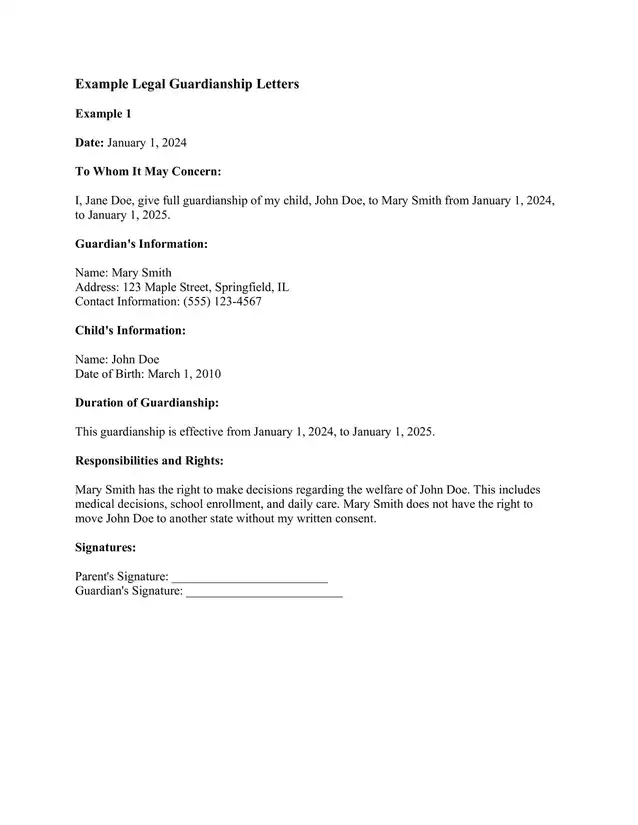
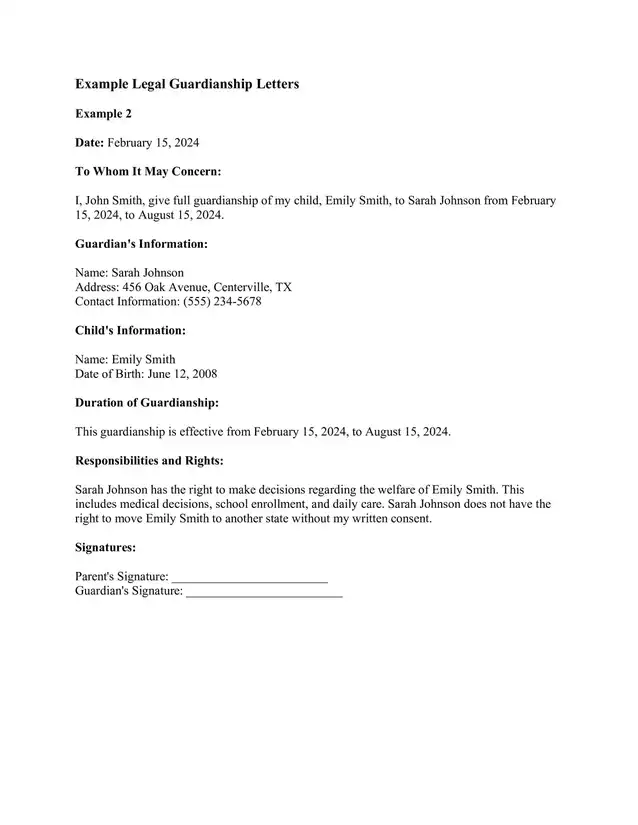
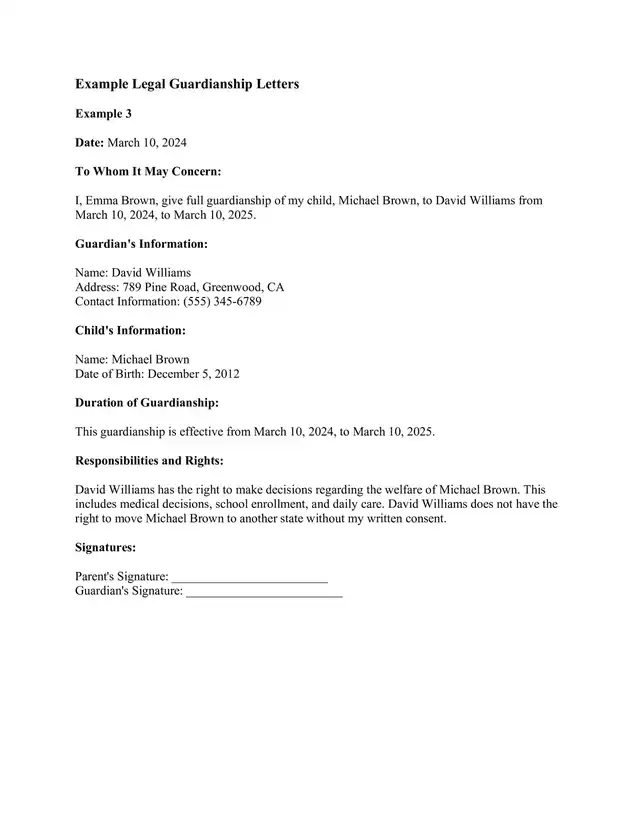
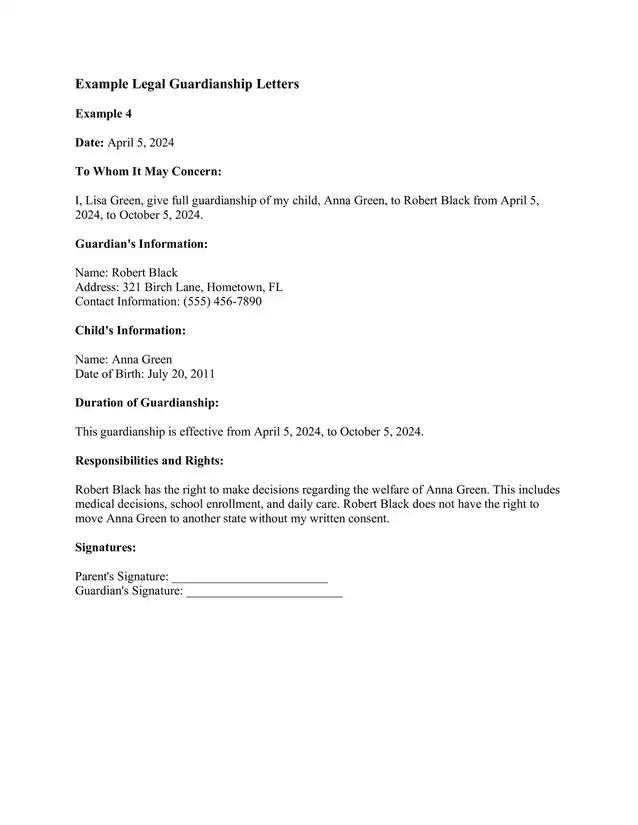
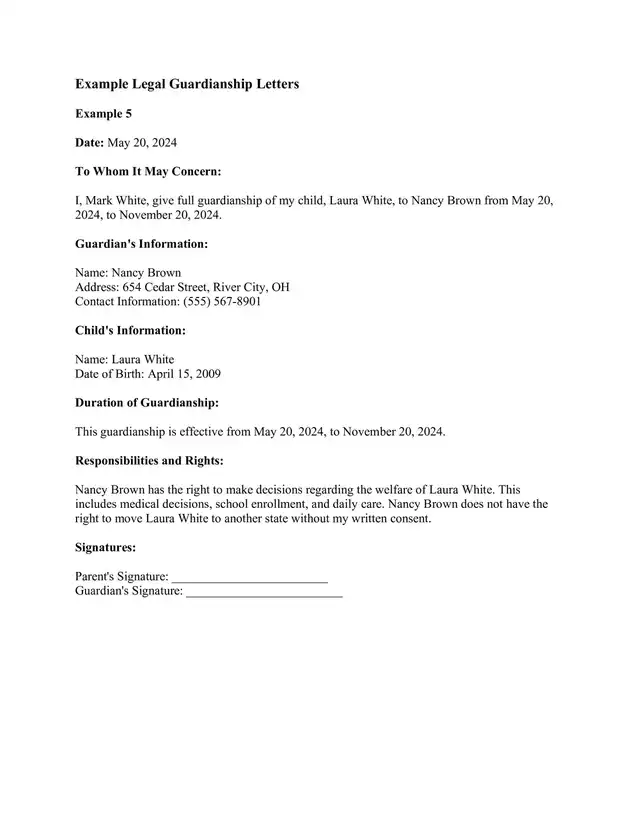
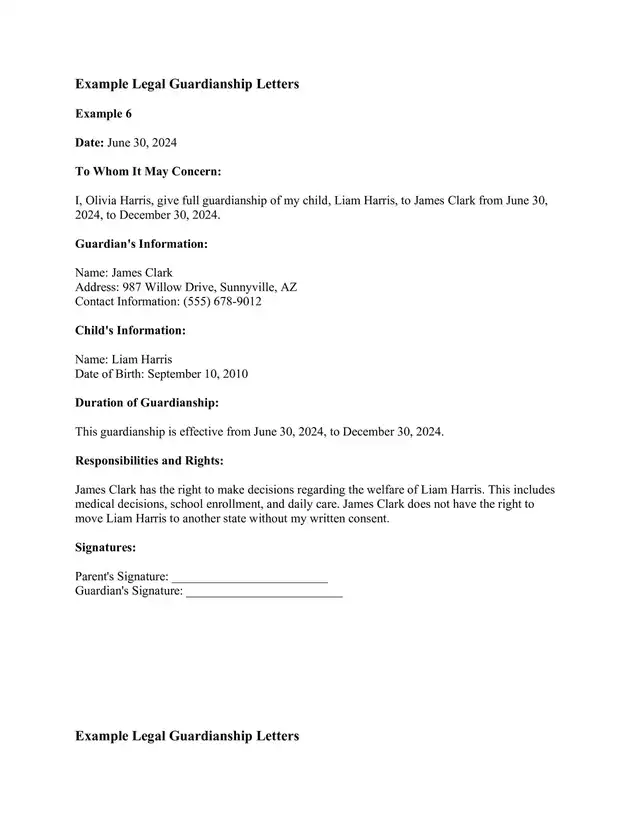
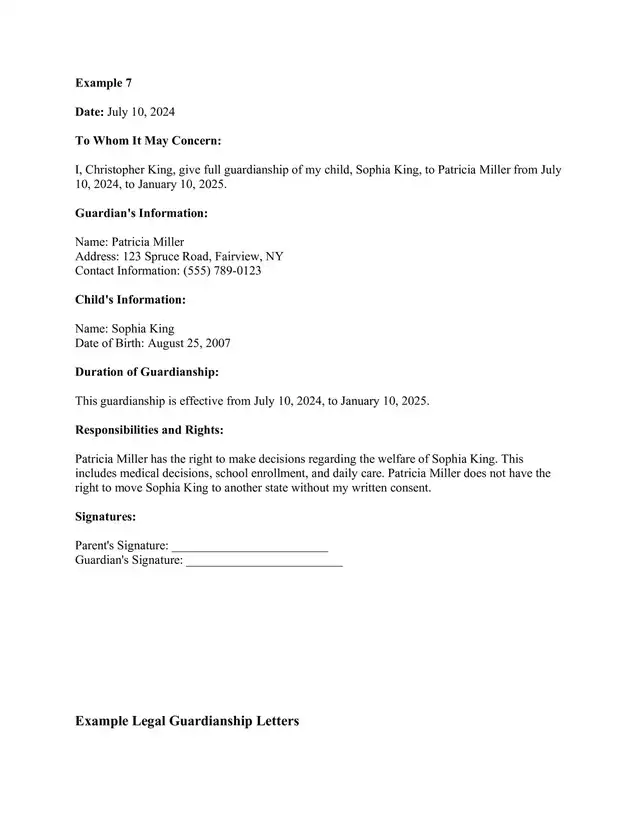
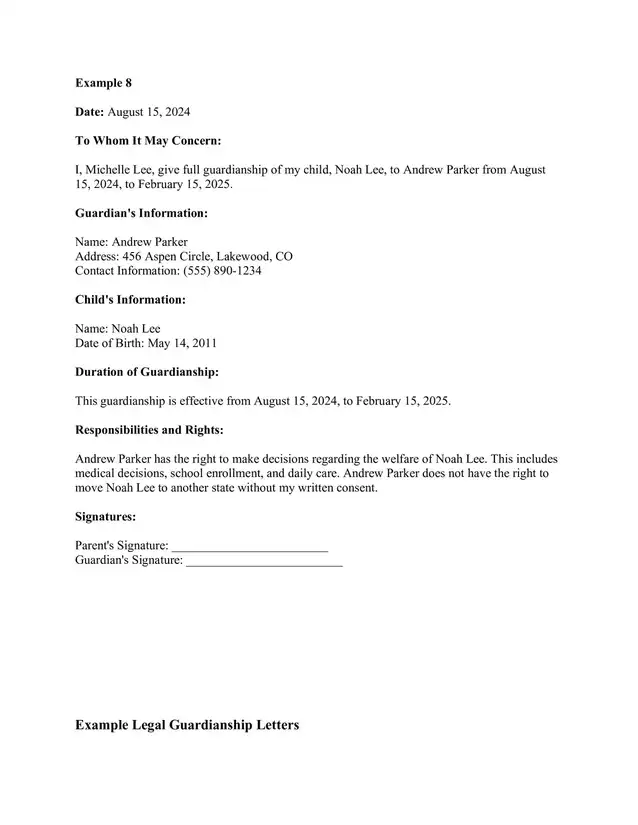
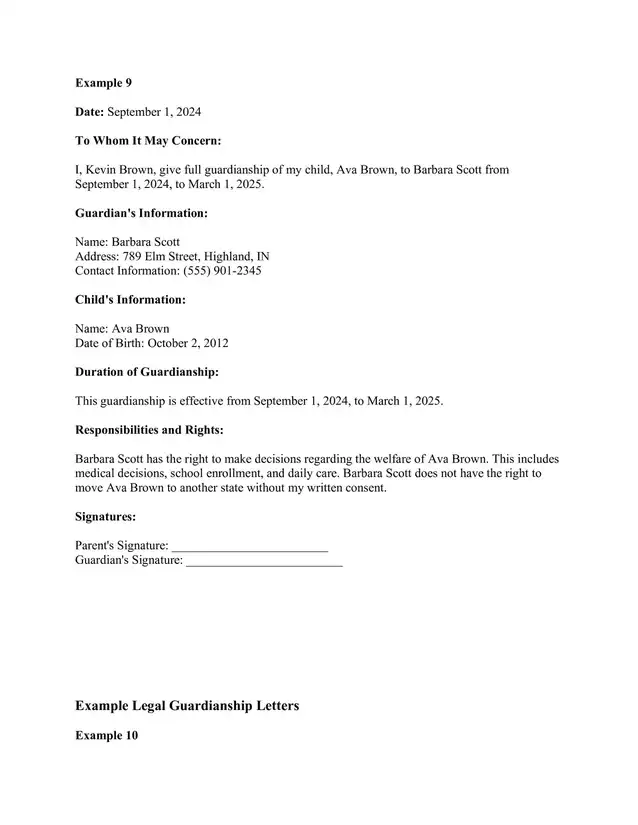
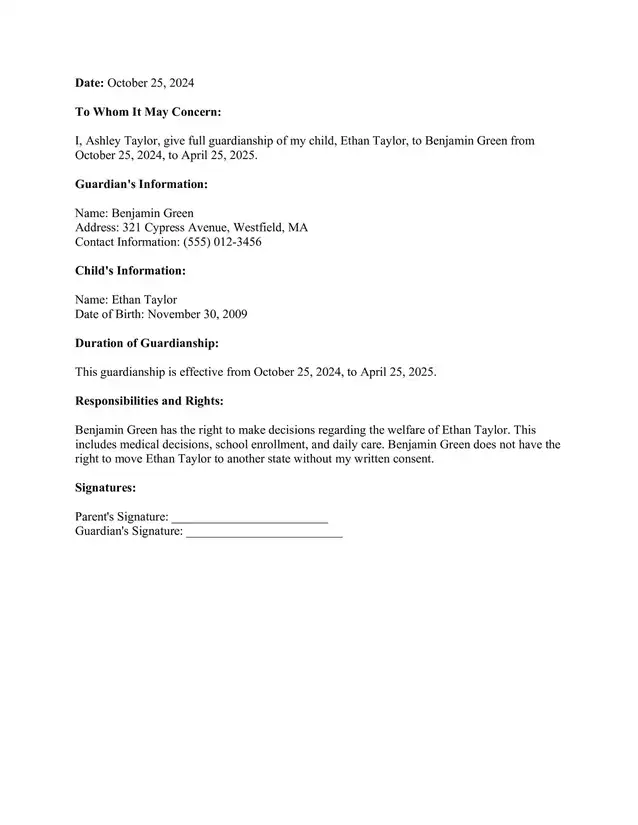
Common Mistakes and How to Avoid Them
Not Being Specific About Responsibilities and Rights
One common mistake is to be more specific about what the guardian can and cannot do. It can confuse you if you don’t clearly state the responsibilities and rights.
To avoid this, write down exactly what the guardian is allowed to do. For example, say if they can make medical decisions, enroll the child in school, or take them on trips. Being clear helps everyone understand their roles.
Forgetting to Get Signatures from Both Parties
Another mistake is forgetting to get signatures from the parent and the guardian. It might be invalid if both parties do not sign the letter.
To avoid this, ensure you and the guardian sign the letter. If both parents have legal custody, both should sign. Signatures show that everyone agrees to the guardianship arrangement.
Not Keeping a Copy of the Letter
Some people must keep a copy of the guardianship letter for their records. This can be a problem if you must show someone the letter later.
To avoid this mistake, always make a copy of the letter and keep it in a safe place. You should show it to schools, doctors, or other authorities.
Not Getting the Letter Notarized
While notarization is not always required, it adds an extra layer of security. Not getting the letter notarized can sometimes make it less trustworthy.
To avoid this, consider having the letter notarized. A notary public will witness the signing and add an official seal. This shows that the signatures are real and the document is authentic.
Not Clearly Stating the Duration of the Guardianship
Sometimes, people must remember to state clearly how long the guardianship will last. This can lead to misunderstandings.
To avoid this, write down the start and end dates of the guardianship. If the duration is indefinite, make that clear, too.
FAQs About Legal Guardianship Letters
Can a legal guardianship letter be used for school enrollment?
Yes, a legal guardianship letter can be used to enroll a child in school. This letter gives the guardian the authority to take care of school matters for the child. The guardian can sign permission slips, attend parent-teacher meetings, and handle other school-related tasks.
Is a notarized legal guardianship letter better?
Yes, a notarized legal guardianship letter is better. When a letter is notarized, a notary public has witnessed the signing. This adds an extra layer of legal protection. It shows that the signatures on the letter are real. Notarization helps ensure the letter is trusted and accepted by schools, doctors, and other authorities.
Can a guardianship letter include medical decisions?
Yes, a guardianship letter can include medical decisions. You can give the guardian the right to make medical choices for the child. This means the guardian can take the child to the doctor, approve treatments, and handle medical emergencies. Including medical decisions in the letter ensures that the guardian can care for the child’s health without legal problems.
What if I want to end the guardianship early?
You can do so anytime if you want to end the guardianship early. You need to write a notice that says the guardianship is ending. Give this notice to the guardian and keep a copy for yourself. This written notice officially ends the guardianship and returns full responsibility for the child to you.
Do both parents need to sign the guardianship letter?
If both parents have legal custody, then yes, both parents need to sign the guardianship letter. This shows that both parents agree to the guardianship arrangement. If only one parent has legal custody, then only that parent must sign. Having both signatures helps prevent legal disputes and strengthens and validates the letter.
Writing a legal guardianship letter is a simple but important step to ensure your child is cared for in your absence. By clearly outlining the guardian’s responsibilities and the duration of the guardianship, you can know that your child will be in good hands.

Daniel Wilson Is a Seasoned communications professional and letter-writing expert. With over a decade of experience in corporate and non-profit sectors, Has developed a deep understanding of the power of effective communication.
Specializes in creating versatile letter templates that can be tailored to any situation. In this blog, Daniel shares a passion for the art of letter writing, offering practical tips, customizable templates, and inspiring ideas to help you communicate with clarity, confidence, and impact.







